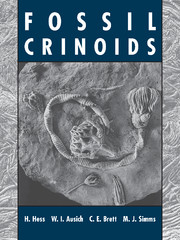Book contents
- Frontmatter
- Contents
- List of Contributors
- Acknowledgements
- Prelude
- Introduction
- GENERAL PART
- 1 Crinoid Form and Function
- 2 Systematics, Phylogeny and Evolutionary History
- 3 Fossil Occurrence
- 4 Taphonomy
- 5 Ecology and Ecological Interactions
- ASSEMBLAGES
- Appendix I Geological Time Table with Crinoid Assemblages
- Appendix II Glossary of Rocks
- Bibliography
- General Index
- Taxonomic Index
3 - Fossil Occurrence
Published online by Cambridge University Press: 10 November 2010
- Frontmatter
- Contents
- List of Contributors
- Acknowledgements
- Prelude
- Introduction
- GENERAL PART
- 1 Crinoid Form and Function
- 2 Systematics, Phylogeny and Evolutionary History
- 3 Fossil Occurrence
- 4 Taphonomy
- 5 Ecology and Ecological Interactions
- ASSEMBLAGES
- Appendix I Geological Time Table with Crinoid Assemblages
- Appendix II Glossary of Rocks
- Bibliography
- General Index
- Taxonomic Index
Summary
CRINOIDAL LIMESTONES
Disarticulated crinoid remains were important rockbuilding constituents during the Palaeozoic and Mesozoic, but especially during the Palaeozoic. Crinoidal limestones range in size and shape from thin, localized lenses to the remarkable regional encrinite deposits that are crinoidal limestones with minimum dimensions greater than a stratigraphic thickness of 5–10 m and an area extent of 500 km2 (Ausich 1997). Regional encrinites are known from the Ordovician to the Jurassic, but they were most common during the Lower Mississippian. The Keokuk and Burlington (Chapter 17) Limestones from Iowa, Missouri and Illinois are the bestknown examples of this facies. These two units have a combined thickness of up to 53 m and geographic extent of more than 74,000 km2 – crinoids and crinoidal sediment dominated an entire shelf for a considerable length of time (H. R. Lane 1978; Thompson 1986; Ausich 1997). Other Palaeozoic examples of regional encrinites include the Middle Ordovician Holston Formation of Tennessee (Walker et al. 1989), the Devonian Sadler Ranch Formation of Nevada and California (Kendall et al. 1983) and the Lower Mississippian Kogruk Formation of Alaska (Sable & Dutro 1961).
In Mesozoic strata, crinoidal limestones decrease in importance, but commonly occur in the Triassic Muschelkalk (see Chapter 21) and in the Lower Jurassic. Typical examples are Liassic sediments of the southern Alps such as the Sinemurian Broccatello and the similar Hierlatz Limestone deposited on restricted shallow swells adjoining pelagic limestones with high proportions of sponge spiculites (Wiedenmayer 1979). The Broccatello (from brocade) was given its name by stone masons; this flaming, multicoloured ‘marble’ has been used in countless Italian and Swiss baroque and rococo churches.
- Type
- Chapter
- Information
- Fossil Crinoids , pp. 41 - 49Publisher: Cambridge University PressPrint publication year: 1999
- 5
- Cited by



